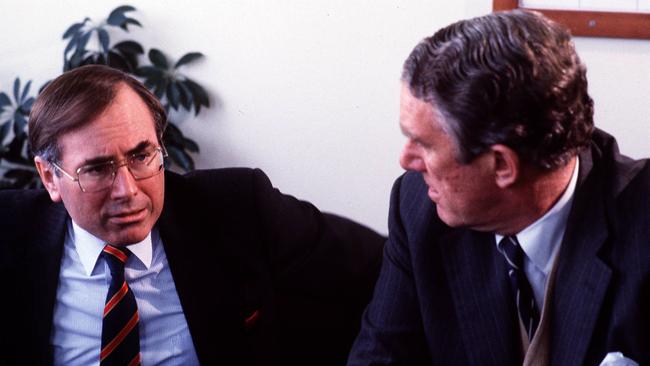When RBA and John Howard went to war over policy
New documents have revealed a three month long stand-off in 1982 between the Reserve Bank and then treasurer John Howard, when the nation came closest to overriding the central bank.

In the closing months of 1982, the government and the Reserve Bank of Australia went to war according to never before seen documents released to The Weekend Australian from the central bank’s archives.
The documents reveal a three-month standoff during which the bank refused a request from then treasurer John Howard, engaging the prospect of the section 11 trigger in the RBA Act.
Section 11 allows the treasurer to override an RBA decision, with Jim Chalmers advocating for the repeal of such powers. While section 11 has never been used, the nation came close in 1982 when Mr Howard formally “requested” the RBA release bank funds, held on mandatory deposit at the RBA, on the explicit requirement banks direct the money into home loans.
At that time, banks were required to hold a fixed percentage of their assets in government securities – known as their LGS ratio (the ratio of liquid assets plus government securities to deposits) – and to lodge a percentage of their assets directly with the RBA. These were known as their SRDs or statutory reserve deposits.
Mr Howard wanted to make a formal request for the RBA to release one percentage point of SRDs back to the banks but also to mandate that they only lend the money for home buying.
The idea was flagged by Mr Howard with the outgoing RBA governor, Harold Knight, in July 1982. But Sir Harold advised Mr Howard not to make a formal request, warning that “there are no winners in a civil war”.
But a formal request was made. It landed on the desk of new governor Robert Johnston in mid-August and Mr Howard made the request public on August 17.
In September and October, Mr Johnston conveyed to Mr Howard that the RBA had difficulties with the request and suggested the government pursue alternative options to achieve higher lending for housing. The issue culminated in November when Mr Johnston put to Mr Howard another solution in which the banks themselves would provide the extra money for home loans.
Mr Howard and Mr Johnston spoke on November 5, with the treasurer making it clear it was a matter of “whether or not the Reserve Bank board refused to make the (SRD) release”. This raised the prospect of a section 11 trigger. “Assuming that the matter is going to proceed in terms of section 11 of the Reserve Bank Act in the event of a difference of opinion … the treasurer and the board should endeavour to reach agreement,” Mr Johnston said in a note for board members. “If they are unable to reach agreement, the board forthwith is to furnish the treasurer a statement … The treasurer may then by order determine the policy.”
Mr Howard did not proceed after the RBA agreed to get the banks to lift home lending.
The documents emerged as former ACTU secretary and RBA board member Bill Kelty said there was still scope for a robust debate about monetary policy, arguing there was nothing wrong with the ACTU’s demand during the week for the central bank to rule out further rate hikes. “Everybody’s getting upset,” he said. “You can’t say anything now.”
But Opposition treasury spokesman Angus Taylor said that, while everyone wanted lower interest rates, “you don’t do it by undermining the independence of the RBA board”.




To join the conversation, please log in. Don't have an account? Register
Join the conversation, you are commenting as Logout